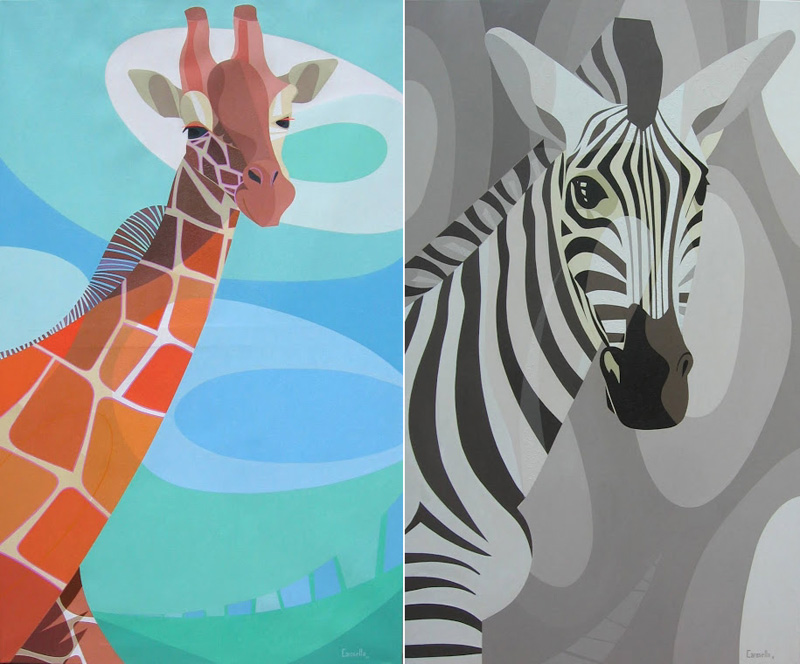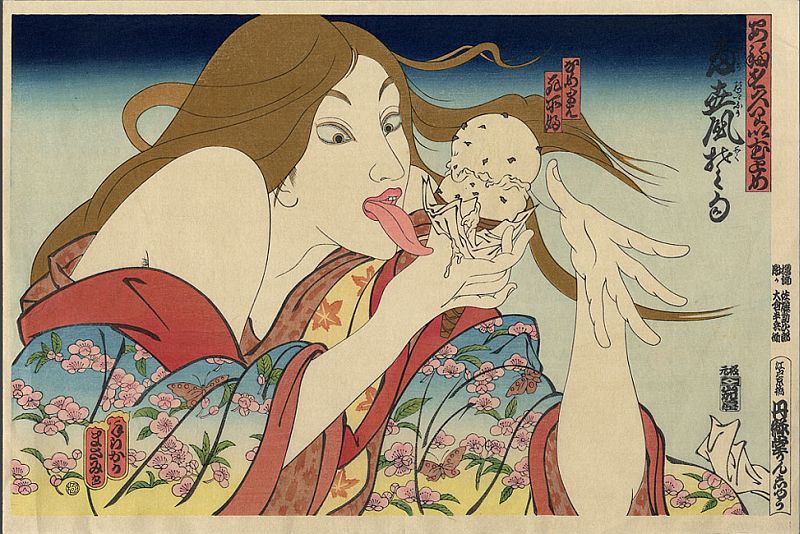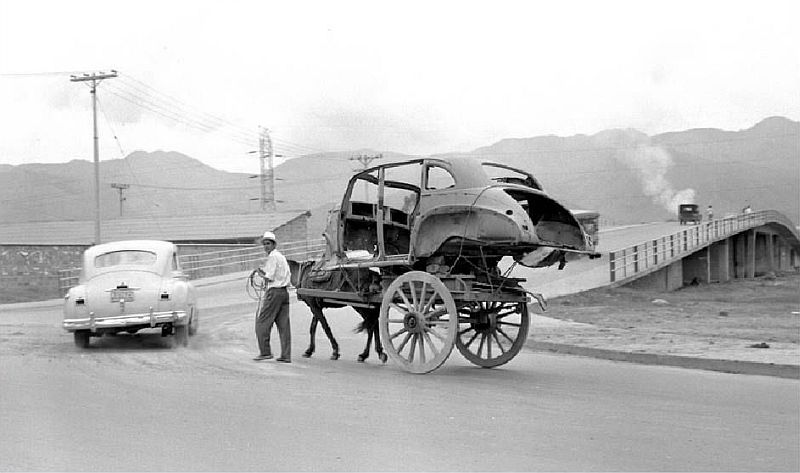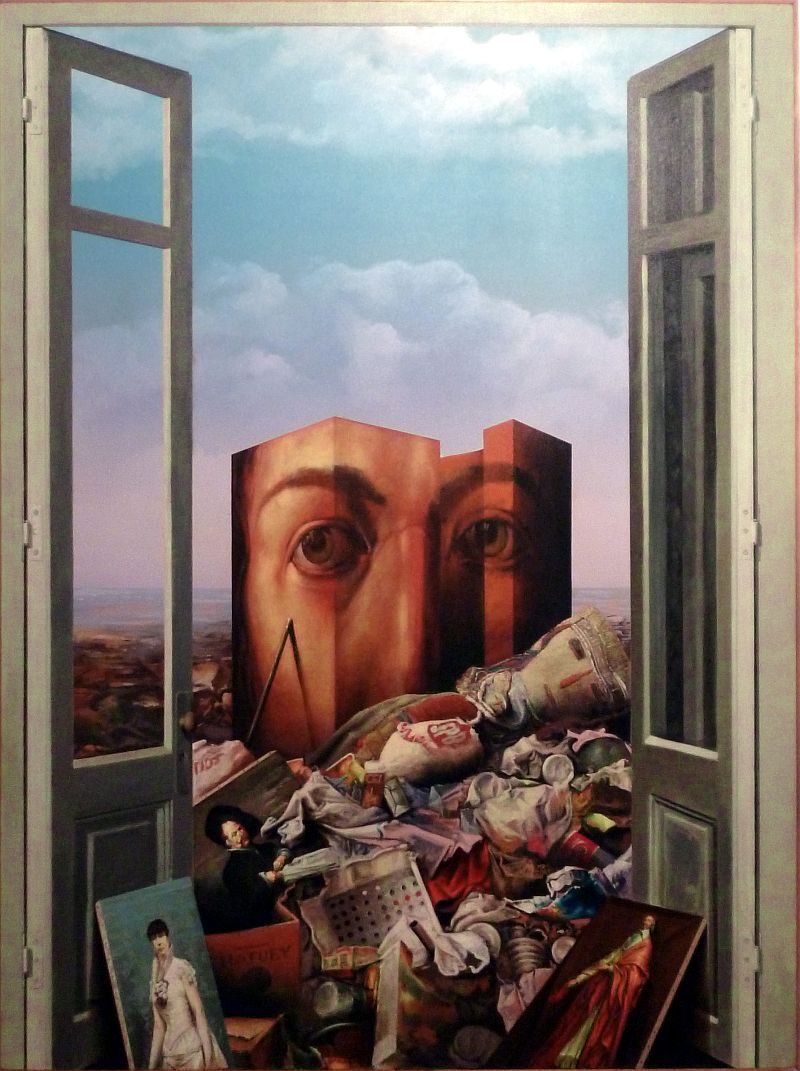En junio de este mismo año publiqué un post dedicado a la notable fotógrafa estadounidense Judy Dater. Mientras seleccionaba imágenes, noté que Judy retrató durante la década de los '70 a una serie de destacados fotógrafos. Todas sus imágenes son realmente buenas. Dedicaré dos posts a esta colección de retratos, lo cual me servirá además para aportar algo de información y presentar algunas de sus obras.
Textos en inglés al final del post, marcados con [*] en cada párrafo.
Judy Dater
Autorretrato / Self Portrait, "La Maga / The Magician", 1981 © Judy Dater
In June this year I published a post dedicated to the remarkable American photographer Judy Dater. While I was selecting pictures, I noticed that during the decade of 1970, Judy portrayed a number of notable photographers. All her photographs are really good. I'll dedicate two posts to this collection of portraits, which will serve me well to provide some information and present some of their works.
English texts at the end of this post, marked with [*] in each paragraph.
______________________________________________________________
Judy y los Fotógrafos /
Judy and the Photographers (I)
Judy and the Photographers (I)
André Kertész, 1979 © Judy Dater
André Kertész fue un fotógrafo nacido en Hungría en 1894, conocido por sus asombrosas contribuciones a la composición y el ensayo fotográficos. Más imágenes e información en los posts previos. [1]
Más sobre Kertész en "El Hurgador" / More about Kertész in this blog:
______________________________________________________________
Brett Weston, 1978 © Judy Dater
Brett Weston (originalmente Theodore Brett Weston) fue un fotógrafo estadounidense nacido en 1911. Van Deren Coke lo describió como el "niño genio de la fotografía estadounidense". Fue el segundo de cuatro hijos del fotógrafo Edward Weston y Flora Chandler.
Weston comenzó a fotografiar en 1925, mientras vivía en México con Tina Modotti y su padre. Comenzó a mostrar sus fotografías con Edward Weston en 1927, fue presentado en la exposición internacional Film und Foto en Alemania a los 17 años, y montó su primera retrospectiva individual a los 21 en el Museo De Young de San Francisco, en enero de 1932.
Murió en 1993. [2]
Sitio web del artista: http://www.brettwestonarchive.com/
"Limo Glacial / Glacial Silt", Alaska, 1978 © The Brett Weston Archive, L.L.C. 2014
______________________________________________________________
Edmund Teske, 1978 © Judy Dater
Edmund Rudolph Teske fue un fotógrafo estadounidense del s.XX nacido en 1911, que combinó una carrera como retratista de artistas, músicos y animadores, con una prolífica producción de fotografía experimental. Su uso de técnicas tales como impresiones combinadas, montajes y solarizaciones, le condujeron a obtener "imágenes a menudo románticas y misteriosas". Aunque expuso extensamente y fue bien conocido durante su vida en los círculos de la fotografía artística, su obra no fue ampliamente conocida por el público. Ha sido llamado "uno de los grandes olvidados de la fotografía estadounidense".
Murió en 1996 [3]
Jim Morrison, 1969
______________________________________________________________
Arnold Newman, 1974 © Judy Dater
Arnold Abner Newman fue un fotógrafo estadounidense nacido en 1918, conocido por sus "retratos ambientales" de artistas y políticos. También destacan sus cuidadosamente compuestas imágenes de bodegones abstractos.
En 1936 estudió pintura y dibujo en la Universidad de Miami. Incapaz de continuar tras dos años, se mudó a Filadelfia para trabajar para un estudio haciendo retratos de 49 céntimos.
Newman encontró su visión en la empatía que sentía por los artistas y su obra. Aunque fotografió a muchas personalidades (Marlene Dietrich, John F. Kennedy, Harry S. Truman, Piet Mondrian, Pablo Picasso, Arthur Miller, Marilyn Monroe, Ronald Reagan, Mickey Mantle, y Audrey Hepburn) sostenía que incluso si el sujeto no es conocido, o si ya se le ha olvidado, la fotografía en sí misma aún debe excitar e interesar al espectador.
Murió en 2006. [4]
Archivo de Arnold Newman: http://www.arnoldnewmanarchive.com/
Igor Stravinsky, 1946
Más sobre Newman en "El Hurgador" / More about Newman in this blog:
______________________________________________________________
Aaron Siskind, 1975 © Judy Dater
Aaron Siskind fue un fotógrafo estadounidense nacido en 1903, generalmente considerado como estrechamente involucrado con (si no parte de) el movimiento del expresionismo abstracto. En su autobiografía escribió que incursionó en la fotografía cuando recibió una cámara como regalo de bodas, y comenzó a tomar imágenes de su luna de miel. Pronto comprendió el potencial artístico que ofrecía. Trabajó tanto en Nueva York como en Chicago.
La obra de Siskind se centra en los detalles de la naturaleza y la arquitectura. Las presenta como superficies planas, para crear una nueva imágen fuera de ellas, la cual, argumentaba, pasaba a ser algo independiente del tema original.
En los inicios de su carrera fue miembro de la Liga Fotográfica de Nueva York. Trabajando con este grupo, Siskind produjo en los años '30 varias series de imágenes con significativo trasfondo social, entre ellas el "Documento de Harlem" es la más famosa.
Murió en 1991. [5]
Fundación Aaron Siskind: http://www.aaronsiskind.org/
"Placeres y terrores de la levitación / Pleasures and Terrors of Levitation" # 37, 1953
______________________________________________________________
Pedro Meyer, 1976 © Judy Dater
Pedro Meyer es un reconocido fotógrafo español nacido en 1935, establecido en México. Es uno de los pioneros de la revolución digital en la fotografía contemporánea. Fue el fundador y presidente del Consejo Mexicano de Fotografía y organizador de los tres primeros Coloquios de Fotografía Latinoamericana.
Además de su obra fotográfica, Meyer ha sido profesor en varias instituciones, así como curador, editor, fundador y director del sitio web de fotografía ZoneZero, que alberga la obra de cerca de 1000 fotógrafos de todo el mundo, y es visitada por más de medio millón de personas cada mes.
Obtuvo la beca Guggenheim en 1987. [6]
Sitio web del artista: http://www.pedromeyer.com/
"Siluetas de Ipanema / Ipanema Silhouettes"
______________________________________________________________
Ralph Gibson, 1979 © Judy Dater
Ralph Gibson es un fotógrafo artístico estadounidense nacido en 1939, conocido por sus libros de fotografía. Sus imágenes a menudo incorporan fragmentos con matices eróticos y misteriosos, construyendo un significado narrativo a través de la contextualización y yuxtaposición surrealista. Gibson actualmente vive en Nueva York y viaja frecuentemente a Europa y Brasil.
Estudió fotografía mientras estaba en la marina de los Estados Unidos, y luego en el Instituto de Arte de San Francisco. Comenzó su carrera profesional como asistente de Dorothea Lange entre 1961 y 1962, y trabajó en dos películas con Robert Frank.
Gibson ha mantenido una fascinación de toda la vida con los libros y la factura de libros. Desde la aparición en 1970 de El Sonámbulo, su obra ha sido constantemente empujada hacia la página impresa. En 1969 Gibson se mudó a Nueva York, donde formó Lustrum Press, para poder ejercer el control sobre la reproducción de su obra. Lustrum Press también publicó Tulsa (1971) de Larry Clark. [7]
Sitio web del artista: http://www.ralphgibson.com/
"Cristine", 1981
______________________________________________________________
Brassaï, 1973 © Judy Dater
Brassaï (seudónimo de Gyula Halász) fue un fotógrafo, escultor, escritor y cienasta húngaro nacido en 1899, que alcanzó la fama internacional en Francia durante el s.XX. Fue uno de los numerosos artistas húngaros que florecieron en París en el período de entreguerras. A principios del s.XXI, el descubrimiento de más de 200 cartas y cientos de dibujos y otros ítems del período 1940 - 1984, ha provisto a los estudiosos de material para comprender el último período de su vida y su carrera. Murió en 1984. [8]
Más sobre Brassaï en "El Hurgador" / More about Brassaï in this blog:
______________________________________________________________
Richard Misrach, 1975 © Judy Dater
Richard Misrach es un fotógrafo estadounidense nacido en 1949 "firmemente identificado con la introducción del color en la fotografía artística en los '70, y con el uso de cámaras tradicionales de gran formato" (Nancy Princenthal, Art in America).
David Littlejohn del Wall Street Journal, llama a Misrach "el fotógrafo estadounidense más interesante y original de su generación", describiendo su obra como desarrollándose "en paralelo a la de Thomas Struth y Andreas Gursky, dos alemanes contemporáneos." Littlejohn apunta que los tres utilizaron gran formato en color que desafió las expectativas de la fotografía artística en su tiempo.
Es quizá mejor conocido por sus representaciones de los desiertos del oeste estadounidense, y por sus series documentando los cambios ejercidos sobre el medio ambiente por varios factores humanos tales como la expansión urbana, el turismo, la industrialización, las inundaciones, incendios, fabricación petroquímica y las pruebas de explosivos y armas nucleares por los militares. [9]
"Pantano y tubería / Swamp and Pipeline", Geismar, Louisiana
(negative 1998, print 2012) Inkjet print by Richard Misrach. High Museum of Art, Atlanta.
______________________________________________________________
Wynn Bullock, 1972 © Judy Dater
Wynn Bullock es un reconocido maestro estadounidense de la fotografía del s.XX, nacido en 1902, cuya obra está incluida en más de 90 colecciones de museos alrededor del mundo. Recibió una sustancial aclamación crítica durante su vida, publicando numerosos libros, y se le menciona en todas las historias standard de la fotografía moderna.
Después de su graduación en la secundaria, se mudó a Nueva York para hacer carrera en la música.
Durante mediados de los '20, prosiguió en Europa, estudiando sobre la voz y dando conciertos en Francia, Alemania e Italia.
Mientras estaba en París, quedó fascinado con la obra de los impresionistas y post-impresionistas. Descubrió la obra de Man Ray y László Moholy-Nagy, y experimentó una inmediata afinidad con la fotografía, no sólo como forma de arte únicamente basado en la luz, sino también como vehículo a través del cual podría involucrarse de manera más creativa con el mundo. Compró su primera cámara y comenzó a tomar fotografías.
Un punto de inflexión en la vida de Bullock como fotógrafo creativo, ocurrió en 1948 cuando conoció a Edward Weston. Inspirado por el poder y la belleza de las impresiones de Weston, comenzó a explorar la "fotografía directa" por sí mismo. [10]
Sitio web del artista: http://www.wynnbullockphotography.com/
"Niño en el bosque / Child in Forest", 1951
______________________________________________________________
Wright Morris, 1975 © Judy Dater
Wright Marion Morris fue un novelista, fotógrafo y ensayista estadounidense nacido en 1910. Es conocido por sus retratos de personas y artefactos de los Grandes Llanos en palabras e imágenes, así como por experimentar con las formas narrativas. Wright Morris murió en 1998 a los 88 años. Está enterrado en el Cementerio Chapman.
Morris recibió numerosos reconocimientos, además del Premio Nacional del Libro por El Campo Visual y Canción de la llanura. Obtuvo la Beca Guggenheim en 1942, 46 y 1954.
El archivo completo de fotografías de Wright Morris está ubicado en el Centro de Fotografía Creativa (CCP) en la Universidad de Arizona en Tucson. [11]
"Bedroom and Washstand / Dormitorio y lavamanos", Sur de Indiana / Southern Indiana, 1950
______________________________________________________________
Más sobre Judy Dater en "El Hurgador" / More about Judy Dater in this blog:
Retratos de los fotógrafos publicados con autorización de la artista (¡Muchas gracias, Judy!)
Portraits of the photographers published with artist's permission (Thanks a lot, Judy!)
Traducción al inglés / English translation.
[1]
André Kertész was an Hungarian-born photographer (1894) known for his groundbreaking contributions to photographic composition and the photo essay. More images and information in previous posts.
[2]
Brett Weston (originally Theodore Brett Weston) was an American photographer born in 1911. Van Deren Coke described Brett Weston as the "child genius of American photography." He was the second of the four sons of photographer Edward Weston and Flora Chandler.
Weston began taking photographs in 1925, while living in Mexico with Tina Modotti and his father. He began showing his photographs with Edward Weston in 1927, was featured at the international exhibition at Film und Foto in Germany at age 17, and mounted his first one-man museum retrospective at age 21 at the De Young Museum in San Francisco in January, 1932.
He died in 1993.
Artist's website: http://www.brettwestonarchive.com/
[3]
Edmund Rudolph Teske was a 20th-century American photographer born in 1911 who combined a career of taking portraits of artists, musicians and entertainers with a prolific output of experimental photography. His use of techniques like: combined prints, montages and solarizations led to "often romantic and mysterious images". Although he exhibited extensively and was well-known within artistic photography circles during his lifetime, his work was not widely known by the public. He has been called "one of the forgotten greats of American photography."
He died in 1996.
[4]
Arnold Abner Newman was an American photographer born in 1918, noted for his "environmental portraits" of artists and politicians. He was also known for his carefully composed abstract still life images.
In 1936, he studied painting and drawing at the University of Miami. Unable to afford continuing after two years, he moved to Philadelphia to work for a studio making 49-cent portraits.
Newman found his vision in the empathy he felt for artists and their work. Although he photographed many personalities—Marlene Dietrich, John F. Kennedy, Harry S. Truman, Piet Mondrian, Pablo Picasso, Arthur Miller, Marilyn Monroe, Ronald Reagan, Mickey Mantle, and Audrey Hepburn—he maintained that even if the subject is not known, or is already forgotten, the photograph itself must still excite and interest the viewer.
He died in 2006.
Arnold Newman Archive: http://www.arnoldnewmanarchive.com/
[5]
Aaron Siskind was an American photographer born in 1903, widely considered to be closely involved with, if not a part of, the abstract expressionist movement. In his autobiography he wrote that he began his foray into photography when he received a camera for a wedding gift and began taking pictures on his honeymoon. He quickly realized the artistic potential this offered. He worked in both New York City and Chicago.
Siskind's work focuses on the details of nature and architecture. He presents them as flat surfaces to create a new image out of them, which, he claimed, stands independent of the original subject.
Early in his career Siskind was a member of the New York Photo League. Working with that group, Siskind produced several significant socially conscious series of images in the 1930s. Among them the "Harlem Document" remains the most famous.
He died in 1991.
Aaron Siskind Foundation: http://www.aaronsiskind.org/
[6]
Pedro Meyer is a well-known photographer born in Spain (1935), based in Mexico. He is one of the pioneers of the digital revolution in contemporary photography. He was the founder and president of the Consejo Mexicano de Fotografía (Mexican Council of Photography) and organizer of the first three Latin American Photography Colloquiums.
Besides his artistic photographic work, Meyer has been a teacher in various institutions, as well as the curator, editor, founder and director of the photography ZoneZero website, which hosts the work of over a thousand photographers from all over the world, and is visited by more than 500,000 people each month.
He was awarded the Guggenheim Fellowship in 1987.
Artist's website: http://www.pedromeyer.com/
[7]
Ralph Gibson is an American art photographer born in 1939, best known for his photographic books. His images often incorporate fragments with erotic and mysterious undertones, building narrative meaning through contextualization and surreal juxtaposition. Gibson currently lives in New York and travels frequently to Europe and Brazil.
Ralph Gibson studied photography while in the US Navy and then at the San Francisco Art Institute. He began his professional career as an assistant to Dorothea Lange from 1961 to 1962 and went on to work with Robert Frank on two films.
Gibson has maintained a lifelong fascination with books and book-making. Since the appearance in 1970 of THE SOMNAMBULIST, his work has been steadily impelled towards the printed page. In 1969 Gibson moved to New York, where he formed Lustrum Press in order to exert control over the reproduction of his work. Lustrum Press also published Larry Clark's Tulsa (1971).
Artist's website: http://www.ralphgibson.com/
[8]
Brassaï (pseudonym of Gyula Halász) was a Hungarian photographer, sculptor, writer, and filmmaker born in 1899, who rose to international fame in France in the 20th century. He was one of the numerous Hungarian artists who flourished in Paris beginning between the World Wars. In the early 21st century, the discovery of more than 200 letters and hundreds of drawings and other items from the period 1940–1984 has provided scholars with material for understanding his later life and career. He died in 1984.
In Wiki: http://en.wikipedia.org/wiki/Brassai
[9]
Richard Misrach is an American photographer born in 1949, "firmly identified with the introduction of color to 'fine' [art] photography in the 1970s, and with the use of large-format traditional cameras" (Nancy Princenthal, Art in America).
David Littlejohn of the Wall Street Journal calls Misrach "the most interesting and original American photographer of his generation," describing his work as running "parallel to that of Thomas Struth and Andreas Gursky, two German contemporaries." Littlejohn notes that all three used a large scale color format that defied the expectations of fine art photography at the time.
He is perhaps best known for his depictions of the deserts of the American west, and for his series documenting the changes brought to bear on the environment by various man-made factors such as urban sprawl, tourism, industrialization, floods, fires, petrochemical manufacturing, and the testing of explosives and nuclear weapons by the military.
[10]
Wynn Bullock is a recognized American master photographer of the 20th century born in 1902, whose work is included in over 90 major museum collections around the world. He received substantial critical acclaim during his lifetime, published numerous books and is mentioned in all the standard histories of modern photography.
After high school graduation, he moved to New York to pursue a musical career.
During the mid-1920s, he furthered his career in Europe, studying voice and giving concerts in France, Germany and Italy.
While living in Paris, Bullock became fascinated with the work of the Impressionists and post-Impressionists. He then discovered the work of Man Ray and László Moholy-Nagy and experienced an immediate affinity with photography, not only as an art form uniquely based on light, but also as a vehicle through which he could more creatively engage with the world. He bought his first camera and began taking pictures.
A major turning point in Bullock’s life as a creative photographer occurred in 1948, when he met Edward Weston. Inspired by the power and beauty of Weston’s prints, he began to explore "straight photography" for himself.
Artist's website: http://www.wynnbullockphotography.com/
[11]
Wright Marion Morris was an American novelist, photographer, and essayist born in 1910. He is known for his portrayals of the people and artifacts of the Great Plains in words and pictures, as well as for experimenting with narrative forms. Wright Morris died in 1998 at the age of 88 years. He is buried in the Chapman Cemetery.
Morris received numerous honors in addition to the National Book Awards for The Field of Vision and Plains Song. He was granted Guggenheim Fellowships in 1942, 1946, and 1954.
The full archive of Wright Morris photographs is located at the Center for Creative Photography (CCP) at the University of Arizona in Tucson.









.jpg)













.jpg)








_-_Volga_Boatmen_(1870-1873).jpg)






'.jpg)

















.jpg)




.jpg)






























_(Japan,_Edo,_1786-1865)_LACMA_M.86.326.5.jpg)












.jpg)

























































































.jpg)


.jpg)








.jpg)
























.jpg)








_-_The_Girl_With_The_Pearl_Earring_(1665).jpg)




.jpg)





.jpg)




.jpg)




%2B2.jpg)




%2B4.jpg)


%2B3.jpg)




























































%2Ben%2Bhonor%2Ba%2BSaramago-SHI-ok.jpg)









.jpg)
.jpg)


















+-+bronzo+dipinto+-+cm.+14+x+47+x+23.jpg)

,+13+x+26+x+19,+bronce+pintado.jpg)
,+2000,+painted+bronze.jpg)










.jpg)







.jpg)



